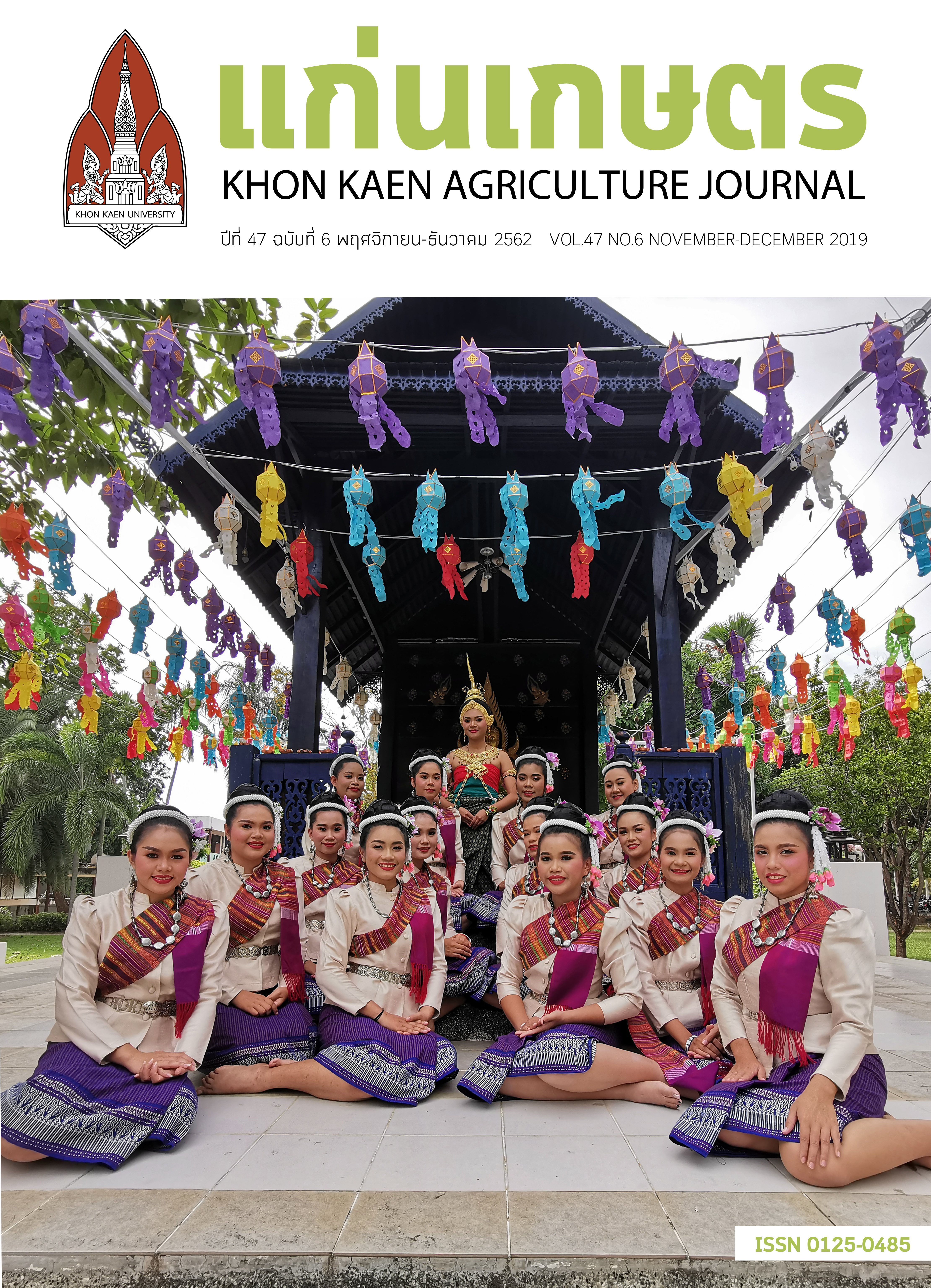การประเมินรูปแบบการกระจายตัวของรากและการตอบสนองทางสรีรวิทยาของอ้อย15 สายพันธุ์โดยใช้วิธีไรโซบ็อกซ์
Main Article Content
บทคัดย่อ
รากมีความสำคัญต่อการดูดน้ำและธาตุอาหารให้แก่ลำต้นเพื่อใช้สำหรับการเจริญเติบโต และมักจะทำหน้าที่สัมพันธ์กับกระบวนการทางสรีรวิทยาของส่วนเหนือดิน ซึ่งการพัฒนาพันธุ์ที่มีระบบราก และการตอบสนองทางสรีรวิทยาที่ช่วยส่งเสริมให้อ้อยมีผลผลิตสูงจึงเป็นสิ่งที่จำเป็น ดังนั้นการศึกษานี้จึงมีวัตถุประสงค์เพื่อประเมินลักษณะรากและการตอบสนองทางสรีรวิทยาของอ้อยทั้ง 15 สายพันธุ์ที่ปลูกในไรโซบ็อกซ์ภายใต้สภาพเรือนทดลอง ณ คณะเกษตรศาสตร์ มหาวิทยาลัยขอนแก่น โดยไรโซบ็อกซ์มีความกว้าง 50 ซม. หนา 10 ซม. และสูง 120 ซม.ตรวจวัดข้อมูลความยาวรากน้ำหนักแห้งรากลักษณะทางสรีรวิทยา (ความเข้มของสีใบ, ประสิทธิภาพในการสังเคราะห์ด้วยแสง, ค่าการนำของปากใบและปริมาณน้ำสัมพัทธ์ในใบ) และน้ำหนักแห้งของส่วนต้นที่อายุ 60 วันหลังย้ายปลูก พบว่าอ้อยแต่ละพันธุ์มีลักษณะรากและการตอบสนองทางสรีรวิทยาที่แตกต่างกัน ซึ่งพันธุ์อ้อยถูกแบ่งออกเป็น 4 กลุ่มตามลักษณะความยาวรากรวม โดย พันธุ์ที่มีความยาวรากรวมมาก คือ อ้อยพันธุ์ KK06-419 นอกจากนี้ยังพบว่าความยาวรากและพื้นที่ผิวสัมผัสรากมีความสัมพันธ์เชิงบวกกับค่าการนำของปากใบ (r = 0.681, p = 0.01 และ r = 0.533; p = 0.5, ตามลำดับ) ในขณะที่ประสิทธิภาพในการสังเคราะห์ด้วยแสงมีความสัมพันธ์เชิงลบกับพื้นที่ผิวสัมผัสรากและปริมาตรราก (r = -0.621; p = 0.05 และ r = -0.618; p = 0.05, ตามลำดับ) ข้อมูลจากการทดลองนี้จะเป็นประโยชน์ในการปรับปรุงพันธุ์อ้อยและงานวิจัยด้านอ้อยในสาขาอื่นได้
Article Details
เอกสารอ้างอิง
ตุลาพร แก้วแก่น และวัฒนา พัฒนากูล. 2549. ผลของสภาวะขาดน้ำจากความแล้งและความเครียดเกลือต่อลักษณะทางสรีรวิทยาบางประการและเมแทบอลิซึมของคาร์โบไฮเดรตในข้าวระยะต้นกล้า. วารสารวิจัย มข. 4: 260-268
แตงไทย ภิญโญ, วัฒนชัย ล้นทม และ ศุจิรัตน์ สงวนรังศิริกุล. 2561. ผลของการขาดน้ำต่อการแลกเปลี่ยนก๊าซของใบอ้อย. วารสารแก่นเกษตร. 46: 99-104.
นิมิตร วรสูต. 2530. รากพืชและวิธีการศึกษา เอกสารประกอบการสอนวิชาธาตุอาหารพืชไร่ ภาควิชาพืชศาสตร์ คณะเกษตรศาสตร์ มหาวิทยาลัยขอนแก่น
รัชดา ปรัชเจริญวนิชย์, ทักษิณา ศันสยะวิชัย, กอบเกียรติ ไพศาลเจริญ และสุรีย์พร ม้ากระโทก. 2555. ผลของการจัดการแปลงอ้อยระยะยาวต่อการกระจายตัวของรากและการให้ผลผลิตอ้อย. แก่นเกษตร 40 ฉบับพิเศษ, 3: 177-184.
สำนักงานคณะกรรมการอ้อยและน้ำตาลทราย. 2560. รายงานพื้นที่ปลูกอ้อยปีการผลิต 2559/60. ค้นข้อมูลจาก www.ocsb.go.th/upload/journal/fileupload/923-9999.pdf เมื่อวันที่ 10 กรกฎาคม พ.ศ.2561.
Azhiri-Sigari, T., Yamauchi, A., Kamoshita, A. and Wade, L. J. 2000. Genotypic variation in response of rainfed lowland rice to drought and rewatering: II. Root growth. Plant Prod. Sci. 3: 180-188.
Bobadilla, I. M., Hernández, M. V., Bobadilla, G. M., García, E. R., Gonzáles, R. G. and Pacheco, I. T. 2017. Rhizobox experimentation module for the study of the rhizosphere. In Engineering Congress (CONIIN), 2017 XIII International. 1-4.
Bohm, W. 1979. Methods of Studying Root System. Ecological Studies 33. Springer-Verlag. Berlin. Fukuzawa, Y., Komiya, Y., Ueno, M. and Kawamitsu, Y. 2009. Relationship between the development of the root system and initial growth of sugarcane. Proc. Crop. Sci. Soc. Jpn. 78: 356-362.
Graca, J. P. and Rodrigues, F.A. 2010. Physiological parameters in sugarcane cultivars submitted to water deficit. Braz. J. Plant Physiol. 22: 189-197.
Heinz Walz GmbH. 1996. Photosynthesis yield analyzer, Mini-PAM, Portable Chlorophyll Fluorometer: Handbook of operation. First edition. Eichenring, Germany.
Jangpromma, N., Songsri, P., Thammasirirak, S. and Jaisil, P. 2010. Rapid assessment of chlorophyll content in sugarcane using a SPAD chlorophyll meter across different water stress conditions. Asian J. Plant Sci. 9: 368-374.
Khonghintaisong, J., Songsri, P., Toomsan, B. and Jongrungklang, N. 2017. Rooting and physiological trait responses to early drought stress of sugarcane cultivars. Sugar Tech. 20: 396-406.
Neumann, G., George, T. S. and Plassard, C. 2009. Strategies and methods for studying the rhizosphere—the plant science toolbox. Plant Soil. 321: 431–456
Penning de Vries, F. W. and Van Laar, H. H. 1982. Simulation of plant growth and crop production. Simulation Monographs, Pudoc, Wageningen.
Puangbut, D., Jogloy, S., Vorasoot, N. and Craig, K. 2018. Root distribution pattern and their contribution in photosynthesis and biomass in Jerusalem artichoke under drought conditions. Pak. J. Bot. 50: 879-886.
Ruttanaprasert, R., Jogloy, S., Vorasoot, N., Kesmala, T., Kanwar, R. S., Holbrook, C. C. and Patanothai, A. 2015. Root responses of Jerusalem artichoke genotypes to different water regimes. Biomass Bioenergy. 81: 369-377.
Sinclair, T.R., and Muchow, R.C. 1999. Radiation use efficiency. Adv. Agron. 65: 215-265.
Smith, D.M., Inman-Bamber, N.G. and Thorburn, P.J. 2005. Growth and function of the sugarcane root system. Field Crops Res. 92: 169–183.
Smith, J. P., Lawn, R. J. and Nable, R. O. 1999. Investigations into the root: shoot relationship of sugarcane, and some implications for crop productivity in the presence of sub-optimal soil conditions. 21: 108-113. In Proceedings of the Australian Society of Sugar Cane Technologists. Australian Society of Sugar Cane Technologists.
Songsri, P., Jogloy, S., Vorasoot, N., Akkasaeng, C., Patanothai, A. and Holbrook, C. C. 2008. Root distribution of drought-resistant peanut genotypes in response to drought. J. Agron. Crop. Sci. 194: 92-103.
Thangthong, N., Jogloy, S., Jongrungklang, N., Kvien, C. K., Pensuk, V., Kesmala, T. and Vorasoot, N. 2017. Root distribution patterns of peanut genotypes with different drought resistance levels under early-season drought stress. J. Agron. Crop. Sci. 204: 111-122.
Thangthong, N., Jogloy, S., Pensuk, V., Kesmala, T. and Vorasoot, N. 2016. Distribution patterns of peanut roots under different durations of early season drought stress. Field Crops Res. 198: 40–49
Trachsel, S., Kaeppler, S. M., Brown, K. M. and Lynch, J. P. 2013. Maize root growth angles become steeper under low N conditions. Field Crops Res. 140: 18-31.
Turner, N. C. 1986. Adaptation to water deficits: A changing perspective. Funct. Plant Biol. 13: 175-190.
Wu, Q., Pagès, L. and Wu, J. 2016. Relationships between root diameter, root length and root branching along lateral roots in adult, field-grown maize. Ann. Bot. 117: 379-390.


